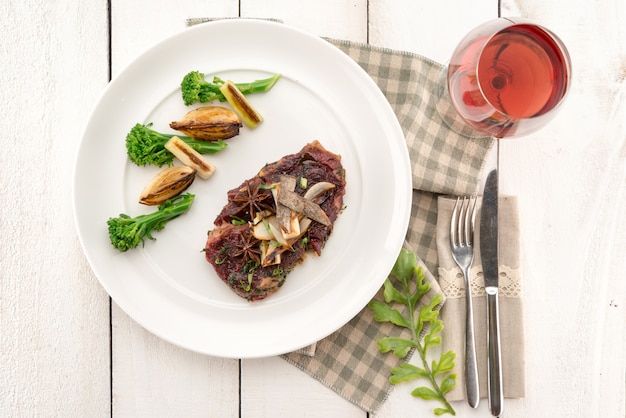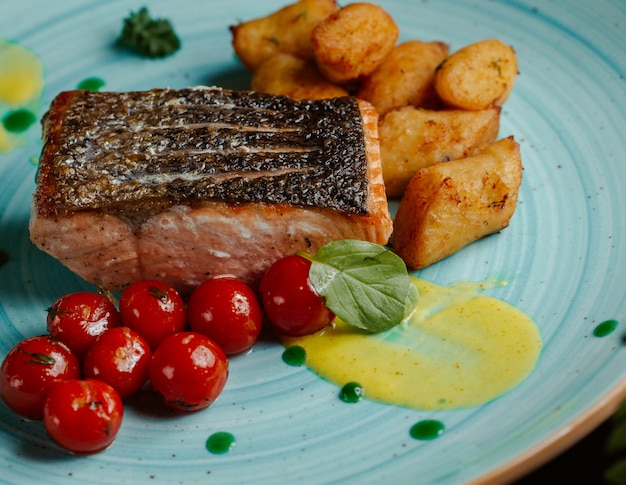(Part 1) Understanding the Filet Mignon

What is Filet Mignon?
Filet mignon, for those who haven't experienced this culinary masterpiece, is actually a specific cut from the tenderloin, the long muscle running along the cow's spine. It's the most tender cut because it's not used for movement, unlike those tough cuts from the legs or shoulders. The filet mignon itself is the smaller, more tender end of the tenderloin, making it the ultimate indulgence.
Think of it this way: the tenderloin is like a long, elegant sausage, and the filet mignon is the most prized section of that sausage. And just like a sausage, it can be sliced into smaller portions, or you can buy the whole thing and roast or grill it. But let's be honest, if you're after that true filet mignon experience, you're going for the individual steaks.
What to Look for in a Filet Mignon
When you're at the butcher counter, there are a few things to keep an eye out for. First, you want beautiful marbling. Marbling refers to the streaks of fat running through the meat, and it's what gives the filet mignon its amazing flavour and juiciness. Imagine a network of little veins running throughout the muscle, that's what you're looking for. A good butcher will gladly explain the different grades of beef, but generally, you want to aim for "Prime" or "Choice" for a truly delicious experience. And of course, make sure your filet mignon is free of any bruises, discoloration, or other signs of mishandling.
Filet Mignon vs. Tenderloin
So, we've established that filet mignon is part of the tenderloin. But what's the difference? Well, the tenderloin is the whole muscle, which can be sliced into individual steaks, including filet mignon. You can also buy the whole tenderloin, perfect for roasting or grilling. But if you're craving that classic filet mignon experience, you're going to want to opt for the individual steaks.
(Part 2) Cooking Techniques

Now we're getting to the good stuff: cooking the filet mignon. There are a few ways to cook this prized cut, each with its own unique charm. Let's explore the most popular methods:
1. pan-seared filet mignon
This is my go-to method, and I think it's the best way to cook a filet mignon. It's quick, easy, and produces a steak with a perfectly crisp crust and a beautifully pink centre. Here's how you do it:
Get your Pan Hot!
The key to a perfect pan-seared filet mignon is a screaming hot pan. Cast iron is ideal, but any good quality skillet will do. We're talking "add a tiny bit of oil and it starts smoking" hot. This intense heat creates that irresistible, crispy crust that we all crave. Don't be afraid of the smoke, it's part of the magic!
Seasoning is Key
Before you even think about touching the pan, season your meat. A simple salt and pepper mix is all you really need, but feel free to get creative. Garlic powder, onion powder, paprika, or even a pinch of cayenne pepper can add a delightful kick. Just remember, season generously, as it's the only flavour the meat will receive!
cooking time: A Dance with Heat
Now, the fun part: the cooking! Place your seasoned filet mignon in that super hot pan, and let it sear for about 2-3 minutes on each side. Don't move it around too much, let it form that gorgeous, golden brown crust. Then, reduce the heat to medium-low and continue cooking for another 3-5 minutes, depending on your desired level of doneness. Remember, you can always cook it more, but you can't uncook it! So err on the side of caution.
Rest, You Deserve It
Once your filet mignon is cooked to perfection, take it off the heat and let it rest for 5-10 minutes before slicing. This allows the juices to redistribute throughout the meat, resulting in a much more tender and flavorful steak. Patience, my friend, patience!
2. grilled filet mignon
Grilling is another great way to cook filet mignon. It gives the steak that classic chargrilled flavour and those beautiful grill marks. It's all about getting that grill nice and hot.
Preheating the Grill
Get those coals blazing or those gas burners screaming. You want your grill to be at high heat, around 500°F (260°C). Remember, we're after that crispy crust, so don't be shy with the heat.
Seasoning: Let's Get Spicy
Just like with pan-searing, season your filet mignon generously with salt and pepper, or experiment with other spices. A little bit of smoked paprika can really enhance the flavour.
Grilling Time: A Masterful Flip
Once your grill is super hot, place your filet mignon on it and resist the urge to touch it! Let it cook for about 3-4 minutes on each side, or until you see a nice char. Then, reduce the heat to medium-low and cook for another 5-7 minutes, depending on your desired doneness. Don't forget to flip your steak regularly to ensure even cooking.
Resting: A Moment of Zen
Once your filet mignon is cooked, remove it from the grill and let it rest for 5-10 minutes before slicing. This allows the juices to redistribute, creating a more tender and flavorful steak. Enjoy this moment of anticipation!
3. Oven-Roasted Filet Mignon
For a more hands-off approach, oven-roasting is a great option, especially if you're cooking for a crowd. This method allows you to roast multiple steaks at once.
Preheat Oven: The First Step
Preheat your oven to 400°F (200°C). This will ensure that your steak cooks evenly and quickly.
Seasoning: Unleash Your Creativity
Season your filet mignon generously with salt and pepper, or experiment with your favorite spices. This is your chance to add a personal touch.
roasting time: A Gentle Heat
Place your filet mignon on a baking sheet lined with parchment paper or foil. Roast for 10-15 minutes, depending on your desired level of doneness. If you want a crispy crust, broil the steaks for the last minute or two of cooking.
Resting: A Final Touch
Once your filet mignon is cooked, remove it from the oven and let it rest for 5-10 minutes before slicing. This allows the juices to redistribute, resulting in a more tender and flavorful steak. Don't rush this step!
(Part 3) Doneness Guide

Understanding Doneness: A Key to Success
Now you've got your filet mignon ready to cook, but how do you know when it's cooked to your liking? This is where the doneness guide comes in handy. Filet mignon is best cooked to medium-rare or medium, as this ensures it remains juicy and tender. Here's a simple guide to help you find your perfect doneness:
Doneness Guide: A Visual Reference
Here's a table to help you understand the different levels of doneness, along with their corresponding internal temperatures:
| Doneness | Internal Temperature (°F) | Internal Temperature (°C) | Description |
|---|---|---|---|
| Rare | 125-130 | 52-54 | Cold center, red throughout |
| Medium-Rare | 130-135 | 54-57 | Warm center, pink throughout |
| Medium | 135-140 | 57-60 | Hot center, pink throughout |
| Medium-Well | 140-145 | 60-63 | Hot center, slightly pink |
| Well Done | 145 | 63 | Very hot center, no pink |
meat thermometer: Your Best Friend
The most accurate way to determine doneness is to use a meat thermometer. Insert it into the thickest part of the steak, making sure it doesn't touch any bone. Once the thermometer reaches your desired temperature, you're good to go!
Other Doneness Indicators: Alternative Approaches
If you don't have a meat thermometer, you can use other indicators to determine doneness, but they're less precise. You can check the colour of the juice: rare is red, medium-rare is pink, medium is light pink, medium-well is light brown, and well done is brown. You can also press on the meat: rare will feel soft, medium-rare will feel springy, medium will feel firm, medium-well will feel slightly firmer, and well done will feel very firm.
(Part 4) Sauces and Sides
Sauces for Filet Mignon: The Perfect Pairing
Now you've got the perfect filet mignon, but it's not complete without a delicious sauce. A good sauce can elevate your steak from amazing to extraordinary. Here are a few of my favourite sauce pairings for filet mignon:
- Béarnaise Sauce: This classic French sauce is rich, creamy, and slightly tangy, a perfect complement to the richness of the filet mignon. It's a sophisticated choice for a special occasion.
- Red Wine Reduction: A simple, yet elegant sauce that brings out the best in the beef. Just reduce some red wine with butter, shallots, and herbs. It's a classic for a reason.
- Mushroom Sauce: A rich and earthy sauce that pairs wonderfully with the meaty flavour of filet mignon. It's perfect for those who enjoy a hearty, comforting taste.
- Peppercorn Sauce: A bold and spicy sauce that's perfect for those who like a bit of heat. It adds a delightful kick to the richness of the steak.
Sides for Filet Mignon: A Symphony of Flavors
No filet mignon meal is complete without a selection of delicious sides. Here are a few of my favourites:
- mashed potatoes: Creamy, comforting, and perfect for soaking up all those delicious juices. A classic side that never fails to please.
- Roasted Vegetables: A healthy and colorful addition to your meal. Try roasted asparagus, broccoli, or Brussels sprouts. They offer a nice contrast to the richness of the steak.
- Creamed Spinach: A rich and creamy side that pairs beautifully with the richness of the filet mignon. It's a luxurious and flavorful choice.
- Garlic Bread: A classic side that's always a crowd-pleaser. It adds a delightful aroma and a touch of rustic charm to the meal.
(Part 5) Serving and Enjoying
Serving Filet Mignon: A Presentation to Remember
Now your filet mignon is cooked to perfection and your delicious sides are ready to go. But there's one more thing to consider: how you're going to serve it. After all, presentation matters!
Start with the right plate. A simple white plate will do, but a more elegant plate, like a black or gold-rimmed plate, can really elevate the presentation. Carefully slice your filet mignon against the grain. This will ensure that the steak is tender and easy to chew. Arrange your slices on the plate and drizzle with your chosen sauce. Add your sides to the plate, making sure you've got a good balance of colors and textures. And finally, don't forget to garnish your plate with a sprig of fresh herbs or a few cherry tomatoes. A final touch goes a long way.
Enjoying Filet Mignon: A culinary journey
Now, it's time to enjoy the fruits of your labour! Take a bite of that perfectly cooked filet mignon, savor the tender texture and rich flavour. Don't forget to pair it with a nice glass of red wine. After all, you deserve it!
(Part 6) Tips and Tricks: Mastering the Art
1. Don't Overcook It! The Golden Rule
The most important thing is to not overcook your filet mignon. Overcooked filet mignon will be dry and tough, a culinary tragedy! So, err on the side of caution and take it off the heat a little early. You can always cook it a little more, but you can't uncook it! Trust your instincts and don't overcook it!
2. Use a Meat Thermometer: Your Culinary Compass
A meat thermometer is your best friend when cooking filet mignon. It takes the guesswork out of cooking and ensures that your steak is cooked to perfection. Invest in a good meat thermometer and use it every time you cook filet mignon. It's a small investment for a big difference in results.
3. Let It Rest: A Moment of Patience
Remember, letting your filet mignon rest is crucial for ensuring it stays juicy and tender. It allows the juices to redistribute throughout the meat, resulting in a more flavorful and satisfying steak. Be patient and let your filet mignon rest for 5-10 minutes before slicing.
4. Season It Generously: Flavor is Key
Filet mignon is lean, so it needs to be seasoned generously. Don't be shy with the salt and pepper! A little bit of garlic powder, onion powder, or paprika can also add a nice flavour boost.
5. Don't Be Afraid to Get Creative: Embrace Your Inner Chef
Filet mignon is a blank canvas for your culinary creativity. Don't be afraid to experiment with different sauces, sides, and seasonings. You might just discover your new favourite filet mignon recipe!
(Part 7) Where to Buy Filet Mignon: Finding the Perfect Cut1. Local Butcher Shop: A Personal Touch
My go-to place for filet mignon is always a local butcher shop. They'll have a better selection of cuts and grades of beef, and they can even trim and cut the steaks to your exact specifications. They're also more likely to be knowledgeable about meat, so they can give you some helpful tips on how to cook it. Plus, you'll be supporting your local community, a win-win!
2. Supermarkets: A Convenient Option
Most supermarkets also carry filet mignon. Just be sure to check the date and the grade of the beef. You'll also want to look for a piece of meat that has good marbling. And remember, don't be afraid to ask the butcher for help! They're usually happy to guide you.
3. Online Meat Delivery Services: A Modern Solution
If you don't have a local butcher shop or if you're looking for a specific type of beef, online meat delivery services can be a good option. These services offer a wide variety of cuts and grades of beef, delivered right to your door. Just be sure to check the delivery fees and shipping times before you order.
(Part 8) Storing and freezing filet mignon: Preserving Your Treasure
Storing Filet Mignon: A Short-Term Strategy
If you're not cooking your filet mignon right away, store it in the refrigerator for up to 3-5 days. Wrap the steak tightly in plastic wrap or aluminum foil to prevent it from drying out. Make sure to store it on a plate or in a container to catch any juices that might leak out.
Freezing Filet Mignon: A Long-Term Solution
You can also freeze filet mignon for up to 3-4 months. First, wrap the steak tightly in plastic wrap, then in aluminum foil or freezer paper. This will help to prevent freezer burn. Label the package with the date so you know how long it's been frozen. When you're ready to cook the filet mignon, thaw it in the refrigerator for 1-2 days. Never thaw it at room temperature, as this can promote bacteria growth.
FAQs: Your Burning Questions Answered
1. What is the best way to cook filet mignon?
The best way to cook filet mignon depends on your personal preferences. Pan-searing is my favourite method, as it produces a steak with a beautifully crisp crust and a juicy centre. Grilling is another great option, as it gives the steak that classic chargrilled flavour. And if you're looking for a more hands-off approach, oven-roasting is a good choice.
2. How do I know when filet mignon is cooked to my liking?
The most accurate way to determine doneness is to use a meat thermometer. Insert the thermometer into the thickest part of the steak and cook until it reaches your desired temperature. You can also use other indicators, such as the colour of the juice or the feel of the meat, but these are less precise.
3. What are the best sauces for filet mignon?
Some classic sauces that pair well with filet mignon include Béarnaise sauce, red wine reduction, mushroom sauce, and peppercorn sauce. It really comes down to your taste preferences.
4. What sides go well with filet mignon?
Some delicious sides for filet mignon include mashed potatoes, roasted vegetables, creamed spinach, and garlic bread. You can't go wrong with any of these classics.
5. How do I store filet mignon?
You can store filet mignon in the refrigerator for up to 3-5 days. Wrap it tightly in plastic wrap or aluminum foil to prevent it from drying out. You can also freeze filet mignon for up to 3-4 months. Wrap it tightly in plastic wrap, then in aluminum foil or freezer paper to prevent freezer burn.
With this comprehensive guide, you're ready to tackle the culinary world of filet mignon. So go forth, master the art of cooking this exquisite cut, and enjoy the delicious results!Everyone is watching

Corn on the Cob: The Ultimate Guide to Perfectly Cooked Ears
Healthy MealsAh, corn on the cob. Just the name evokes images of sunny days, barbecues, and that sweet, juicy flavour that ...

Perfect Pork Roast Oven Cooking Time: A Guide to Delicious Results
Healthy MealsThere's something truly satisfying about a perfectly roasted pork. The aroma alone is enough to make your mout...

Scallops: The Ultimate Guide to Perfect Cooking
Healthy MealsAh, scallops. Those delicate, sweet, and utterly delicious morsels of the sea. They hold a special place in my...

Ham Cooking Time: How Long to Bake, Smoke, or Boil a Delicious Ham
Healthy MealsAh, ham. It's a classic, isn't it? A real crowd-pleaser, especially around holidays. And when done right, it'...

Spaghetti Squash: The Ultimate Guide to Cooking and Serving
Healthy MealsRemember that time you saw spaghetti squash at the supermarket, looking all bumpy and strange, and thought, "W...
